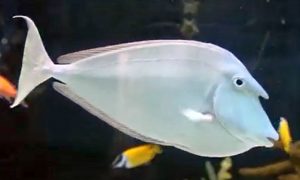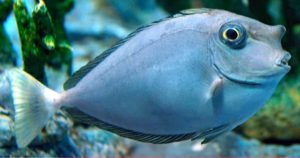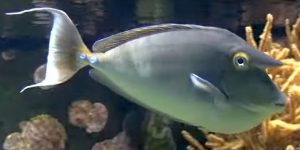The Unicorn Tang (Naso unicornis) known to tropical fish keeping enthusiasts as the Bluespine Unicorn Tang, Bluespine Unicornfish, Bluespine Unicorn, Brown Unicornfish, Long Snouted Unicornfish, Longnose Unicornfish, and plain old Unicornfish is widespread throughout the Indo Pacific from the Red Sea to Japan, the Rapa Islands, Hawaii, Tuamotu, and the Marquesas.
The Unicorn Tang (Naso unicornis) is most frequently found in small to medium large schools in the shallower waters of moats, lagoons, canals, and seaward reefs of their range that have strong water movement, at depths between 15 to over 265 feet where they graze on coarse, leafy brown algae (like Sargassum) and occasionally zooplankton. Several encounters of Naso unicornis were documented along the steep outer reef walls at depths to 590 feet.
Juvenile Bluespine Unicorn Tangs are normally found in the shallower waters of harbors and protected bays at depths from 10 to 250 feet. Adults and juveniles are seldom found alone
The Unicorn Tang or Bluespine Unicornfish has a deeply elongated, oval body shape with a narrower caudal peduncle (a feature that distinguish this genus from other Acanthurids), a protruding snout with a light blue cast to the lips, and visible muscle insertions. Adult Unicorn Tangs have a grayish, blue green to olive green body color with blue hues, and yellowish tones along the belly, bright blue edged dorsal and anal fins, and four bright blue curved knife like spines on the caudal peduncle near the tail.
As the fish grow into adulthood, the caudal fins develop elongated filaments or streamers, but the most identifying feature of the Unicorn Tang is the prominent rostral horn that begins to develop when the fish reaches about five inches in length and continues throughout adulthood.
Males have slightly longer horns than the females and are more intensely colored, especially during their courtship rituals. The horn never reaches beyond the snout.
Because juvenile Unicorn Tang can quickly grow to over 24 inches in length, they need to be housed in a FOWLR or reef aquarium of at least 350 gallon capacity with a crushed coral or sandy substrate, substantial amounts of aged live rock arranged into caves, crevices, and overhangs for them to hide among, and plenty of free swimming space. They are peaceful fish that are perfect for community tanks but may get aggressive with other surgeonfish of their own genus. They should never be housed with aggressive triggerfish or predatory species that could swallow them whole.
Unicorn Tangs are well suited for large reef systems and although a hungry specimen may occasionally pick on the slime that clams and LPS corals produce, they will generally ignore invertebrates and corals.
Like all tangs, Naso unicornis need a lot of water turbulence to thrive, so a strong protein skimmer, good filtration, and regular small water changes are mandatory to prevent illness. In the wild cleaner wrasses (Labroides sp.) remove parasites from their bodies, so adding one or more to the tank should be considered.
Because of the large gallon requirements needed, Unicorn Tangs have not been bred in a home aquarium environment.
Like most tangs, the Unicorn Tang will eat meaty foods along with other fish in the tank but they are primarily herbivores that require huge amounts of marine seaweed and algae to strengthen their immune systems, reduce aggression, and improve their overall health.
In addition to the mature live rock in the tank; Spirulina flakes, seaweed, and dried nori tied to a rock or clipped on a veggie clip should be provided at least 3 times per week. Sea Veggies, Seaweed Salad, and Ocean Nutrition are all ideal products that are convenient to use.
Although the Unicorn Tang (Naso unicornis) is more suitable for public aquariums and is not recommended for the average tropical fish keeping enthusiast; they are available from specialty fish shops and online from wholesalers, retailers, and trans shippers at the following approximate purchase sizes: Juvenile: Small: 1-1/2″ to 2-1/4″; Medium: 2-1/4″ to 4-1/4″; Large: 4-1/4″ to 6-1/4″ XLarge: 6-1/4″ to 7″; With horn: Large: 5″ to 7″; XLarge: 7″ to 12″. Prices start at $79.99 for small to $750.00 for XLarge Indo Pacific specimens.
Minimum Tank Size: 350 gallons
Aquarium Type: Reef or FOLR
Care Level: Moderate
Temperament: Semi Aggressive
Aquarium Hardiness: Very Hardy
Water Conditions: 72-78° F, dKH 8-12, pH 8.1-8.4, sg 1.020-1.025
Maximum Size: 27.5″
Color Form: Blue, Green
Diet: Herbivore
Compatibility: Reef or FOWLR
Origin: Indo-Pacific, Red Sea, Africa, Hawaii, Australia
Family: Acanthuridae
Lifespan: 30 years
Aquarist Experience Level: Professional




